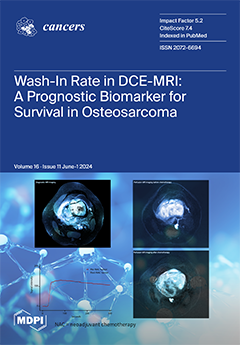High expression of the receptor tyrosine kinase (RTK) insulin-like growth factor-1 receptor (
IGF1R) and RTK mutations are associated with high-risk/worse prognosis in multiple myeloma (MM). Combining the pIGF1R/pINSR inhibitor linsitinib with the proteasome inhibitor (PI) bortezomib seemed promising in a clinical
[...] Read more.
High expression of the receptor tyrosine kinase (RTK) insulin-like growth factor-1 receptor (
IGF1R) and RTK mutations are associated with high-risk/worse prognosis in multiple myeloma (MM). Combining the pIGF1R/pINSR inhibitor linsitinib with the proteasome inhibitor (PI) bortezomib seemed promising in a clinical trial, but IGF1R expression was not associated with therapy response. Because the oncogenic impact of
IGF1R mutations is so far unknown, we investigated the functional impact of
IGF1R mutations on survival signaling, viability/proliferation and survival response to therapy. We transfected four human myeloma cell lines (HMCLs) with
IGF1RWT,
IGF1RD1146N and
IGF1RN1129S (Sleeping Beauty), generated CRISPR-Cas9
IGF1R knockouts in the HMCLs U-266 (IGF1R
WT) and L-363 (IGF1R
D1146N) and tested the anti-MM activity of linsitinib alone and in combination with the second-generation PI carfilzomib in seven HMCLs.
IGF1R knockout entailed reduced proliferation. Upon IGF1R overexpression, survival signaling was moderately increased in all HCMLs and slightly affected by
IGF1RN1129S in one HMCL, whereby the viability remained unaffected. Expression of IGF1R
D1146N reduced pIGF1R-Y1135, especially under serum reduction, but did not impact downstream signaling. Linsitinib and carfilzomib showed enhanced anti-myeloma activity in six out of seven HMCL irrespective of the
IGF1R mutation status. In conclusion,
IGF1R mutations can impact IGF1R activation and/or downstream signaling, and a combination of linsitinib with carfilzomib might be a suitable therapeutic approach for MM patients potentially responsive to IGF1R blockade.
Full article






